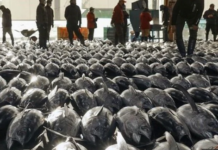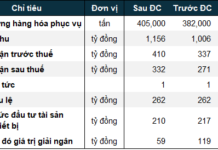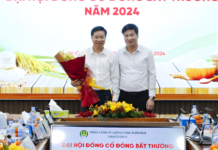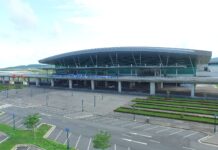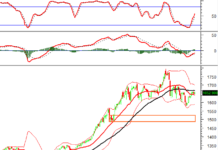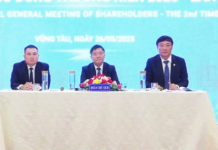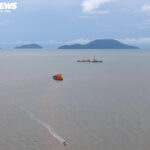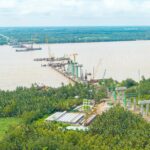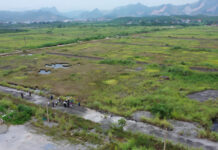The Tran De deep-sea port project, located in the former Soc Trang province, now part of Can Tho City, is considered strategically vital for the entire Mekong Delta region. Once operational, the port is expected to alleviate long-standing logistics bottlenecks, as most of the region’s exports currently rely on road transportation to ports in Ho Chi Minh City, significantly increasing costs.
While numerous deep-sea ports have been established across Vietnam, from the North to the South, the Mekong Delta still lacks such infrastructure. This has been a long-standing aspiration for local authorities in the region.
“However, the economic feasibility of the Tran De port project remains a critical question,” noted Master’s holder Doan Manh Thang, Director of Water & Planning at Haskoning Vietnam, part of the Royal HaskoningDHV (Netherlands) group, during a press briefing on November 18.
The expert highlighted two primary challenges for the Tran De deep-sea port project.
First, Tran De is situated in a river delta area, where heavy siltation makes it impractical to build a port close to the mainland. Regular dredging is necessary, but natural water depths remain insufficient for large vessels. Technically, the port must be constructed 16 kilometers offshore, requiring the construction of an equally long sea-crossing road. Only at this distance is the water deep enough for large ships to navigate.
Second, the initial investment is substantial. While the port’s construction can be phased to reduce capital pressure, the surrounding breakwater system must be built simultaneously, making it the most costly component.
“The total investment must reach billions of USD for Can Tho City to own the Tran De port,” stated Mr. Thang.
According to Mr. Thang, the former Soc Trang province, now Can Tho City, has invited private investors to study the project. However, the costs of building the sea-crossing road, breakwater system, and logistics infrastructure 16 kilometers offshore are prohibitively high, while the volume of goods remains limited. Investment feasibility is a critical concern.
“The economic viability of the Tran De deep-sea port will require more time. When the Mekong Delta’s economy grows and there is sufficient export supply to attract large vessels, investors will be more likely to engage,” he explained.

Rendering of Tran De Port. Photo: T.T
|
Alternative Option: Hon Khoai Port
Given these challenges, Haskoning suggests prioritizing the Hon Khoai deep-sea port in Ca Mau province instead of focusing on Tran De. According to the Mekong Delta’s master plan, the region is slated to have two deep-sea ports: Tran De and Hon Khoai.
Hon Khoai’s advantage lies in its connectivity infrastructure. The government has invested in a highway from Ho Chi Minh City to Ca Mau, and an 18-kilometer sea-crossing bridge connecting Ca Mau’s tip to Hon Khoai began construction in August 2025. Additionally, the area is less affected by siltation, eliminating the need for frequent dredging.
“With these factors, the development of the Tran De port could be delayed, while the Hon Khoai port should be expedited,” advised Haskoning’s representative.
On November 7, during a group discussion on the draft Law on Planning (amended) and adjustments to the National Master Plan for 2021-2030, with a vision to 2050, Minister of Finance Nguyen Van Thang emphasized that alongside port investment, the choice of export routes is equally important.
The Minister noted that a large-scale port like Tran De would require an investment of billions of USD, potentially reaching 2-3 billion USD. Private investors need to see a stable supply of goods to ensure returns, which remains unclear. This uncertainty has hindered the project from attracting strategic investors over the years.
In May, the Ministry of Construction issued a decision approving the “Detailed Planning for the Development of Soc Trang’s Port Land and Water Areas for 2021-2030, with a vision to 2050.”
The total investment needed by 2030 is approximately 61.513 trillion VND, including 19.607 trillion VND for public maritime infrastructure and 41.906 trillion VND for port terminals (covering only cargo handling services).
The Ministry of Construction prioritizes the construction of public offshore port infrastructure at Tran De (shipping lanes, breakwaters, sea-crossing bridges) and aims to accommodate vessels of 100,000-160,000 tons by 2030.
Tran Chung
– 05:45 20/11/2025
Spectacular Milestone Achieved: Vietnam’s Second-Longest Main Span Bridge, Featuring a Tower Equivalent to a 35-Story Building, Surpasses Construction Timeline
The construction site of the Dai Ngai 1 Bridge is currently operating 30 work fronts, mobilizing over 400 engineers, workers, and 150 pieces of machinery. It is anticipated that the pier body and cap beam sections will be completed before the Lunar New Year 2026.
Climate Change Threatens to Erase a Decade of Vietnam’s Economic Growth
The World Bank (WB) warns that without adequate adaptation measures, climate change could slash Vietnam’s GDP by at least 12.5% by 2050 compared to baseline projections. This would effectively erase nearly a decade of growth, significantly hindering the nation’s goal of achieving high-income status by 2045.
Vietnam’s Pioneer in Frozen Agricultural Exports to Europe, US, Japan: Record 9-Month Profit, Stock Hits All-Time High
With nearly 50 years of expertise, Antesco (ANT), Vietnam’s pioneer in frozen vegetable exports, has released its Q3 2025 financial report.





